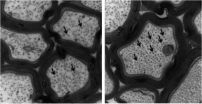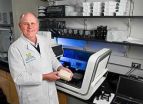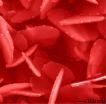(Press-News.org) When the storm winds blow, wind turbines have to show what they can stand up to. The wind blows hard against mills with the force of tons as the tips of the blades plow through the air at more than 200 kilometers per hour. But natural forces not only tear at wind turbines; machine components made of plastic or airplane wings must with stand substantial loads as well.
These days, we normally use sensors to measure whether these components are strained beyond capacity, and it requires a lot of effort to install them into the component parts or glue them onto their surface. Because these monitoring sensors usually only register tensile or pressure loads in a small range, we link several individual sensors to create a single network if we want to record greater areas on the component. Researchers at Fraunhofer Institute for Manufacturing Technology and Applied Material Research (IFAM) in Bremen, Germany, are now making it measurably easier to inspect these large-scale components because they have come up with a new composite material especially for components made of plastic. It has sensory properties that can be directly worked or installed into a synthetic component when it is manufactured. This material also meets design requirements.
This new composite material is a blend of plastic and metal better known as polymer-metal composite material. There is a wide range of plastics that are suited as a matrix material for manufacturing this composite, which means that it can easily be tailor-made for a whole series of purposes. But it also has other advantages. First of all, due to its synthetic character, this material can be easily processed. Beyond this, it is lightweight and conducts current and heat very well due to the high proportion of metal in it. What is especially fascinating about this material is the fact that it can be processed with conventional machines used in plastics manufacturing – among other things, in extruders or in injection-molding machines in which the heated liquid plastic is injected into a form where it hardens immediately. Finally, this material can be laminated as a type of mat on large surfaces. In the future, researchers want to use nozzles to apply this conducting plastic as a viscous liquid to geometrically complex surfaces.
This polymer-metal composite material has its high proportion of metal and a special mixing technique to thank for its excellent sensory properties. As Arne Haberkorn, the project manager for composite developments at the Fraunhofer Institute for Manufacturing Technology and Applied Material Research, points out, "we reach a metallic filling proportion of as much as 90 percent in weight in this composite when needed," with the composite's electrical resistance changing if there are loads during operation. The signals can be drawn off with cables on the component part and passed them onto a measuring instrument for analysis.
It was a special challenge for Haberkorn and his colleagues to come up with a technique for evenly processing different metallic substances in liquid plastic. This new technique functions with a whole range of synthetic materials, for instance with polypropylene just as well as with polyamide. Haberkorn is happy to say "this means we can combine our polymer-metal composite material with various synthetics and process them into a wide range of component parts. That includes not only solid and heat-resistant, but also soft-flexible workpieces." Researchers have used various prototypes to demonstrate that the method functions and are now searching for potential industrial users.
INFORMATION:
Plastic monitors itself
2010-10-19
ELSE PRESS RELEASES FROM THIS DATE:
Few nurse practitioners, physician assistants pursue careers in pediatric health
2010-10-19
ANN ARBOR, Mich. — Pediatric health care work force planning efforts are increasingly incorporating the roles of nurse practitioners and physician assistants, especially in plans to alleviate the perceived shortage of pediatric subspecialists.
However, results from four new studies of pediatric nurse practitioners, family nurse practitioners, neonatal nurse practitioners, and pediatric physician assistants published online today in the journal Pediatrics do not seem to support that idea. The work was conducted by the University of Michigan's Child Health Evaluation and ...
Penn study gives hope for new class of Alzheimer's disease drugs
2010-10-19
PHILADELPHIA – Finding a drug that can cross the blood-brain barrier is the bane of drug development for Alzheimer's disease and other neurological disorders of the brain. A new Penn study, published this week in the Journal of Neuroscience, has found and tested in an animal model of Alzheimer's disease a class of drug that is able to enter the brain, where it stabilizes degenerating neurons and improves memory and learning.
In the normal brain, the protein tau plays an important role in stabilizing structures called microtubules in nerve cells, which serve as tracks ...
ORNL theorist part of team that discovers unexpected magnetism
2010-10-19
OAK RIDGE, Tenn., Oct. 18, 2010 -- Theoretical work done at the Department of Energy's Oak Ridge National Laboratory has provided a key to understanding an unexpected magnetism between two dissimilar materials.
The results, published in Nature Communications, have special significance for the design of future electronic devices for computations and telecommunications, according to co-author Satoshi Okamoto of ORNL's Materials Science and Technology Division. The work was performed at Universidad Complutense de Madrid, synchrotron radiation facilities in France and Japan, ...
Four new psoriasis 'hotspots' identified by U-M geneticists
2010-10-19
ANN ARBOR, Mich. — Scientists at the University of Michigan Heath System and their collaborators have found four new DNA "hotspots" that may one day help guide new treatments for psoriasis, one of the most common autoimmune diseases in the country.
Using cutting-edge methods to peer into the hidden genetic underpinnings of the disabling and disfiguring disease, the research, published in Nature Genetics, further maps the as-yet unknown territories of psoriasis and psoriatic arthritis.
The findings could lead to new drug targets and tailored treatments for the skin ...
Japanese researchers report on liver transplantation studies using animal and iPS cells
2010-10-19
Tampa, Fla. (October 18, 2010) –Two research teams from the Okayama University Graduate School of Medicine (Okayama, Japan) have reported breakthrough studies in liver cell transplantation. One team found that the technical breakthrough in creating induced pluripotent stem cells (iPS) from mouse somatic cells (nonsex cells) in vitro had "implications for overcoming immunological rejection." Whereas a second team using liver cell xenotransplantation - transplanting cells of one species into another (in this case transplanting pig liver cells into mice) - found that transplanted ...
Vitamin D deficiency linked to lung transplant rejection
2010-10-19
MAYWOOD, Ill. -- Vitamin D deficiency is associated with a significant increase in lung transplant rejection, according to research conducted at Loyola University Health System (LUHS). These data were presented Monday at The American Society for Bone and Mineral Research 2010 annual meeting in Toronto, Ontario.
"Vitamin D deficiency is prevalent among lung transplant recipients," said Pauline Camacho, MD, study investigator and director of the Loyola University Osteoporosis and Metabolic Bone Disease Center. "This study shed greater light on the serious impact that this ...
Does clenching your muscles increase willpower?
2010-10-19
The next time you feel your willpower slipping as you pass that mouth-watering dessert case, tighten your muscles. A new study in the Journal of Consumer Research says firming muscles can shore up self-control.
Authors Iris W. Hung (National University of Singapore) and Aparna A. Labroo (University of Chicago) put study participants through a range of self-control dilemmas that involved accepting immediate pain for long-term gain. In one study, participants submerged their hands in an ice bucket to demonstrate pain resistance. In another, participants consumed a healthy ...
Breakthrough in nanocrystals growth
2010-10-19
Argonne, ILL—For the first time scientists have been able to watch nanoparticles grow from the earliest stages of their formation. Nanoparticles are the foundation of nanotechnology and their performance depends on their structure, composition, and size. Researchers will now be able to develop ways to control conditions under which they are grown. The breakthrough will affect a wide range of applications including solar-cell technology and chemical and biological sensors. The research is published in NANOLetters.
As coauthor Wenge Yang of the Carnegie Institution's ...
How do beauty product ads affect consumer self esteem and purchasing?
2010-10-19
A new study in the Journal of Consumer Research found that ads featuring beauty products actually lower female consumers' self-esteem.
"One of the signature strengths of the advertising industry lies in its ability to transform seemingly mundane objects into highly desirable products," write authors Debra Trampe (University of Groningen, the Netherlands), Diederik A. Stapel (Tilburg University), and Frans W. Siero (University of Groningen). In an advertisement, a lipstick situated next to a stiletto heel represents glamour and a teddy bear in an ad for fabric softener ...
Is team science productive?
2010-10-19
PHILADELPHIA - Taking a cue from the world of business-performance experts and baseball talent scouts, Penn Medicine translational medicine researchers are among the first to find a way to measure the productivity of collaborations in a young, emerging institute. They published their findings the most recent issue of Science Translational Medicine.
While metrics exist to measure the contributions of individual scientists, judging the effectiveness of team science has been more challenging. Reasoning that team science produces papers and grants, first author postdoctoral ...




